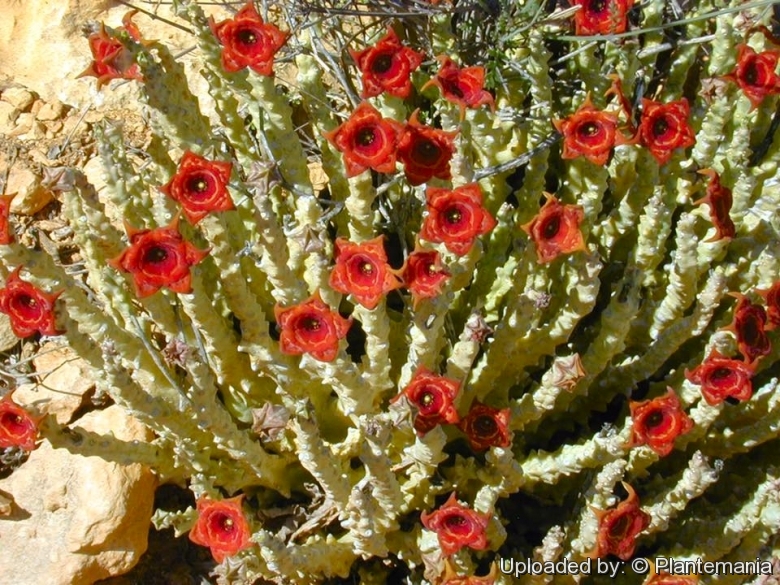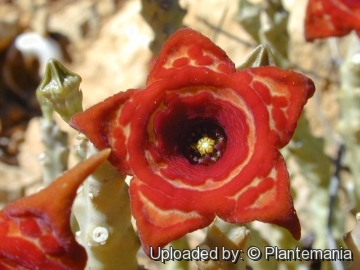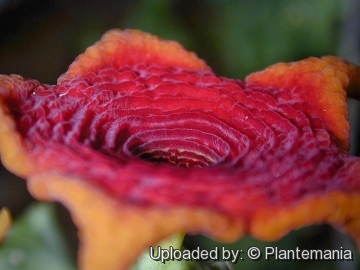
Caralluma socotrana Photo by: © Plantemania
Origin and Habitat: Island of Socotra (just off of the northeast shoulder of Africa in the Indian Ocean - Yemen), Ethiopia. Somalia, and the desert regions of Kenya.
Altitude range 120–1500 metres above sea level.
Synonyms:
See all synonyms of Caralluma socotrana
back
Accepted name in llifle Database:Caralluma socotrana (Balf.f.) N.E.Br.Gard. Chron. III, 12: 370 1892Synonymy: 7
back
Description: Caralluma socotranaSN|27557]]SN|27557]] is one of the most bizarre species in the genus with symmetrically jointed stems that make it look like a pale green coral. But its peculiarly are its unique, almost glistening, vermilion flowers. It is one of the showiest of all the succulent Asclepiadaceae. It is closely related to Caralluma cicatricosa.
Habit: It is a small clump-forming, perennials succulent, up to 30 cm tall and wide branched both from the base and irregularly apically. The whole plant is smooth
Stems: Up to 15 cm tall 0.8-1 cm in diameter (lateral stems apically 3-5 mm in diameter) pale green to bluish-green with brownish- or blackish-green tubercle, with pungent odour, edges blunt. Tubercles oblong-conical and stems undulate in outline.
Leaves: Rudimental, small, deltoid, compressed, cartilaginous, apically brown, and papillate.
Inflorescence: 1-flowered, subterminally from axils, or few-flowered pseudo-umbels.
Flowers: Star-shaped, velvety bright red to orange. Pedicels 1-3 mm long (5-7 mm at Fr ripening). Sepals 2-2.5 mm, alternating with small glands. Corolla about 20-30 mm wide; tube 6-20 mm long 9-11 mm in diameter campanulate, yellow with red or brownish dots, limb vivid red or brownish-red with concentric, darker ridges. Corolla-lobes approx. 5 x 5 mm, broadly triangular or ovate-triangular, shortly acuminate, horizontally spreading. margins strongly recurved with marked sinuses between them, uniformly dark red. Corona 3.5–4.5 mm high, dark purple-red, the outer lobes so deeply divided that they look like basal appendages of the inner lobes, apical margins densely white-ciliate. Anthers 0.8 x 0.5 mm. Pollinia 0.35 x 0.3 mm roundish-ovate, flat, translator wings 0.1 mm. The flowers stink of rotten flesh to attract pollinators.
Blooming season: The Caralluma socotranaSN|27557]]SN|27557]] flowers in the Autumn. The flowers are short lived lasting one to several days at most.
***Fruits:** Pale green-yellow spotted with purple, approx. 10 cm long and 0.5 -0.8 cm in diameter and containing papery seeds.
Bibliography: Major references and further lectures
1) M. Gilbert, D. Goyder, J. Lavranos, S. Liede-Schumann, M. Thulin, and J. Venter “Flora Somalia” Vol 3 2006
2) Focke Albers, Ulrich Meve “Illustrated Handbook of Succulent Plants: Asclepiadaceae: Asclepiadaceae” Volume 4 Springer, 2002
3) Gary Brown, Bruno Mies “Vegetation Ecology of Socotra” Springer, 22/May/2012
 Caralluma socotrana Photo by: © Plantemania
Caralluma socotrana Photo by: © Plantemania Caralluma socotrana Photo by: © Plantemania
Caralluma socotrana Photo by: © Plantemania Caralluma socotrana Photo by: Giuseppe Distefano
Caralluma socotrana Photo by: Giuseppe Distefano Caralluma socotrana Photo by: © Plantemania
Caralluma socotrana Photo by: © PlantemaniaCultivation and Propagation: Caralluma socotranaSN|27557]]SN|27557]] is a particularly difficult plant to keep because of its very specific growing needs with much light and relatively high (above 15°C) winter temperatures. This is primarily a result of it being somewhat fast growing and short-lived by nature. It’s very susceptible to rot in combination with low temperatures, but given the right growing conditions it is an easy blooming plant. The goal with this plant is to grow it as fast as possible in the heat and full sun of summer (lots of water!) and hope for flowers the first or second season and then try to keep it alive during winter with lighter, but regular watering. Pieces of stems may be used to start new plants, so it is worth a try!
Watering: It require moderately watering through the growing season but enjoy plenty of water and some fertiliser in hot weather and allow them to dry before watering again , this helps them to flower freely. Water sparingly in winter according to temperatures. But, as with most asclepiads, it is unwise to leave them wet in cold weather. Winter care presents no problems at 15°C with plenty of light. Since roots are quite shallow, use a cactus mix or add extra perlite or pumice to regular soil potting soil. A gritty, very free-draining compost is suitable, and clay pots help the plants to dry out between watering.
Sun Exposure: Partial sun or light shade
Pest and diseases: They are very susceptible to stem and root mealy bugs, and damage from these may well initiate fungal attack. If you do have problems with a stem or with basal rotting, you can reliably isolate the healthy parts, dry them off, and re-root them in moist compost.
Cultural Practices: Re-pot every 2 years.
Propagation: Easiest with stem cuttings. Allow cuttings to dry a day before planting. Stems must be laid (Not buried) on gritty compost and will then root from the underside of the stems. It can also be increased from seeds sowing in spring in moist, sandy peat moss.
Potting medium: Since roots are quite shallow, use a cactus mix or add extra perlite or pumice to regular soil potting soil. A gritty, very free-draining compost is suitable, and clay pots help the plants to dry out between watering.














